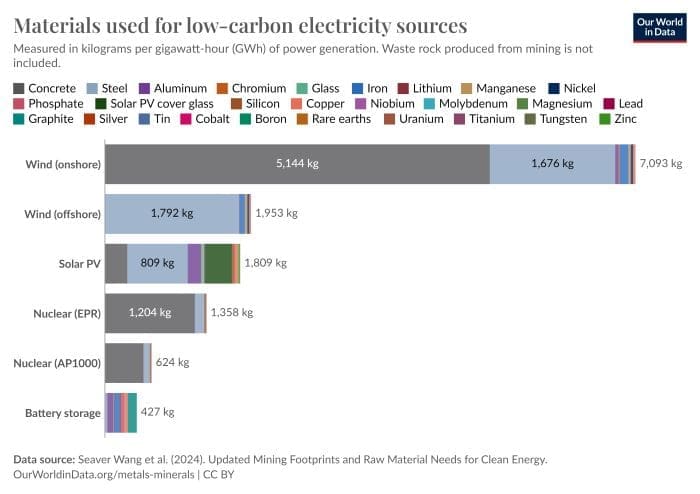Mining for coal is much more resource-intensive than renewables or nuclear power.
Hannah Ritchie‘s article published at Our World Data highlights the important fact that a transition to low-carbon energy, while requiring significant mineral extraction, still results in far less mining compared to the fossil fuel-driven energy systems currently in place. This crucial analysis presents a reality check against common assumptions that renewable energy technologies will greatly exacerbate mining activities.
Building a low-carbon economy requires materials like silicon, nickel, lithium, and cobalt for solar panels and batteries, and iron and steel for wind turbines. At first glance, this seems like a monumental mining challenge, with hundreds of millions of tonnes of minerals needing to be extracted over the coming decades.
However, Ritchie stresses that the relevant comparison isn’t with zero mining but with the massive extraction operations already in place for fossil fuels. When considered holistically, including the mining required for coal and gas extraction, it becomes clear that renewables or nuclear power would dramatically reduce the material footprint of energy production. As the article notes: “the alternative to low-carbon energy is not a zero-energy economy: it’s maintaining the status quo of a system powered mostly by fossil fuels.”
Nuclear energy: the least mining-intensive option
Among clean energy sources, nuclear power, particularly advanced reactor designs like the European Pressurized Reactor (EPR) and the smaller AP1000, stands out for its low material requirements.
According to Seaver Wang and colleagues at The Breakthrough Institute, who recently published an updated study on the material needs of different energy sources, nuclear power has the lowest intensity when measured by materials such as concrete, steel, and silicon. The study also reveals that solar panels, wind turbines, and batteries have significantly reduced their material footprints thanks to improvements in technology and design efficiency.
Concrete and steel dominate the material footprint across technologies, especially in wind turbines, which need large amounts of these resources. Solar power also requires rare materials like silver and cobalt, but still has a smaller footprint compared to coal and gas.

Waste rock: a major contributor to mining footprints
A key insight in Ritchie’s article is that mining for low-carbon technologies often produces large quantities of waste rock, as valuable minerals like nickel or lithium are found in low concentrations within ore. As a result, a large volume of rock must be mined and processed to obtain even small amounts of metal. The rock-to-metal ratio (RMR) is used to quantify this, and the RMR for nickel, for example, is 250, meaning that 250 kilograms of rock must be mined to extract one kilogram of nickel.
While this additional material must be factored into the overall environmental footprint, it still pales in comparison to the mining requirements for coal. Coal mining requires vast amounts of material extraction, not only to build power plants but to continuously mine fuel to keep them running.
Coal’s immense mining footprint
Perhaps the most striking takeaway is the comparison between coal and low-carbon technologies. When both construction and fuel extraction are considered, coal requires 26 times more mining than solar power and more than 50 times more than nuclear power. This means that shifting to renewables or nuclear power not only benefits the climate but also drastically reduces the strain on global mining activities.
Natural gas presents a more complex picture. While it has a lower mining footprint than coal, it still requires significant extraction and has a higher environmental impact than renewables or nuclear energy. Comparing the material impacts of gas with other energy sources is difficult due to the difference in how they are mined and used.
Responsible mining and innovation
Although low-carbon energy significantly reduces the need for mining compared to fossil fuels, Ritchie acknowledges that the transition to renewable technologies does not eliminate the environmental and ethical challenges associated with mining. Moving to a clean energy system will shift the demand for different minerals and mining locations, which requires careful management to ensure sustainability and minimize harm to ecosystems and communities.
Innovations in material efficiency, recycling, and governance are essential to mitigating the environmental footprint of low-carbon energy technologies. Stricter regulations on mining practices, increased investment in recycling technologies, and further advancements in clean energy efficiency will be crucial to making this transition as sustainable as possible.
Ultimately, Ritchie’s article underscores a crucial point: maintaining the current fossil fuel system is not only worse for the climate and public health but also requires significantly more mining than a shift to renewable or nuclear energy. Moving to a clean energy system offers an opportunity to reduce environmental damage and build a more sustainable future.
Article Source:
Hannah Ritchie (2024) – ‘Low-carbon technologies need far less mining than fossil fuels’. Published online at OurWorldinData.org. [Online Resource] Read the original article here.
Featured image credit: Freepik




